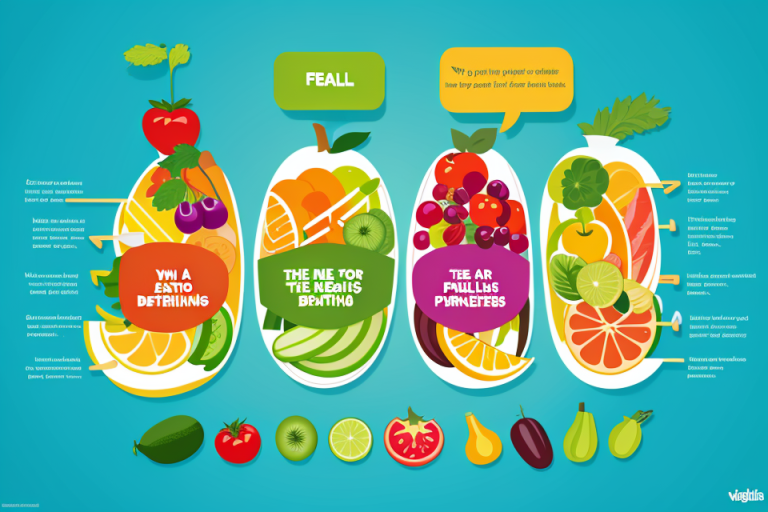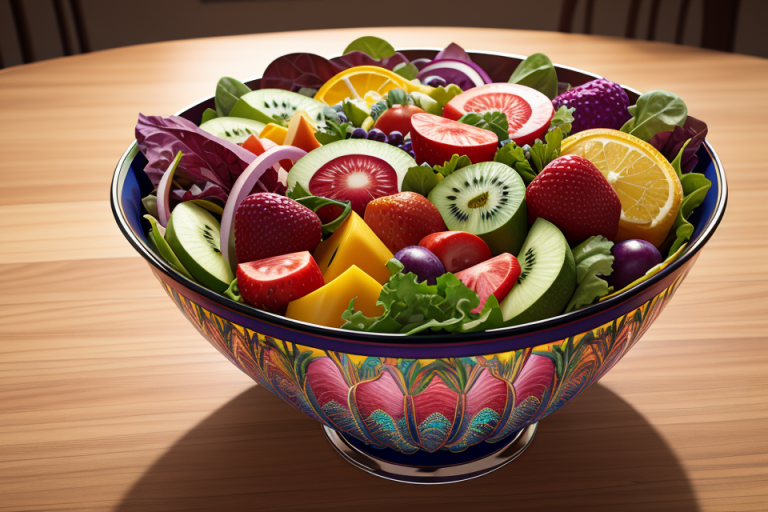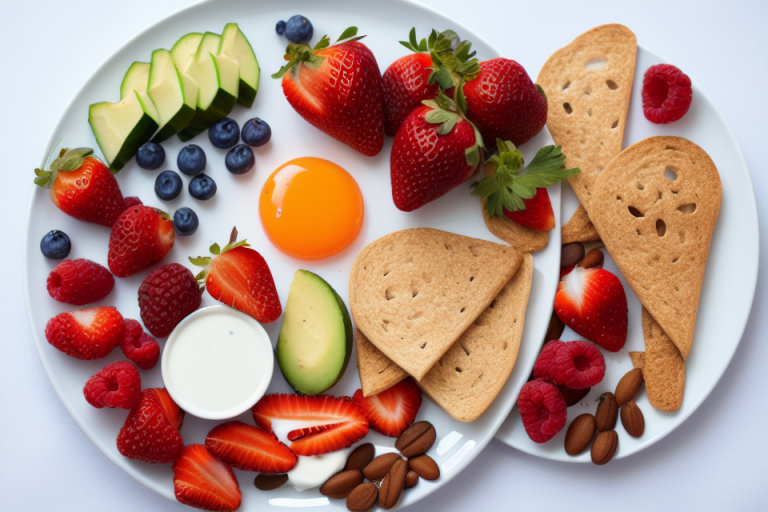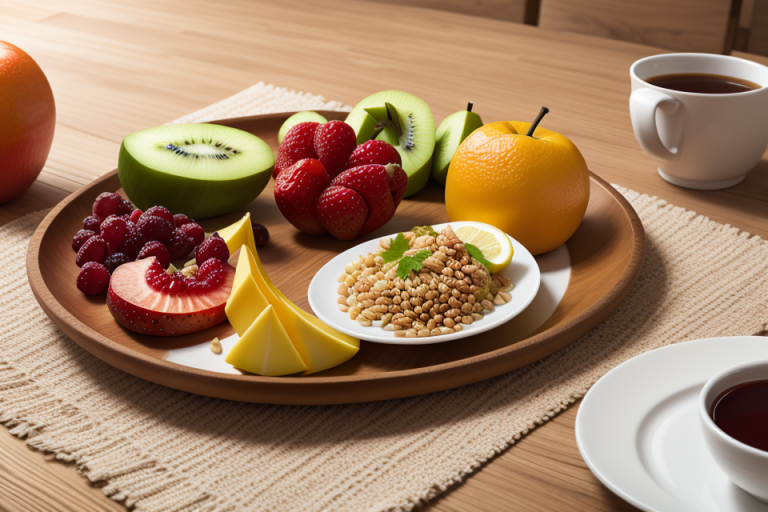Exploring Delicious and Nutritious Meal Options for a Healthier Lifestyle
Healthy eating is not just about depriving yourself of your favorite foods, but rather finding a balance between delicious and nutritious meals. A healthy meal is one that provides the body with essential nutrients needed for optimal health and well-being. Examples of healthy meals include vegetable stir-fries, quinoa salads, grilled fish with roasted vegetables, and Greek yogurt parfaits. These meals are not only tasty but also offer a range of health benefits. In this article, we will explore some examples of healthy meals that can help you adopt a healthier lifestyle. So, get ready to indulge in some mouth-watering dishes that are good for your body and soul!
The Importance of Healthy Meals in a Balanced Diet
Understanding the Role of Nutrients in a Healthy Meal
Nutrients are essential components that our bodies require to function optimally. They are classified into two categories: macronutrients and micronutrients.
Macronutrients: Carbohydrates, Proteins, and Fats
Macronutrients are nutrients that our bodies require in large amounts. They provide energy and support growth and maintenance of the body.
- Carbohydrates: They are the body’s primary source of energy. They are found in foods such as grains, fruits, vegetables, and dairy products. Complex carbohydrates, such as whole grains, are more nutritious than simple carbohydrates, such as sugar.
- Proteins: They are essential for growth and repair of tissues in the body. They are found in foods such as meat, poultry, fish, eggs, dairy products, and legumes.
- Fats: They are vital for the absorption of vitamins and minerals, insulation, and protection of organs. They are found in foods such as nuts, seeds, oils, and animal products.
Micronutrients: Vitamins and Minerals
Micronutrients are nutrients that our bodies require in small amounts. They support various functions in the body, including growth and development, immune function, and metabolism.
- Vitamins: They are organic compounds that are required for various functions in the body, such as energy production, immune function, and growth and development. They are found in foods such as fruits, vegetables, and fortified foods.
- Minerals: They are inorganic elements that are required for various functions in the body, such as muscle and nerve function, bone health, and fluid balance. They are found in foods such as dairy products, meat, and vegetables.
Understanding the role of nutrients in a healthy meal is essential for maintaining optimal health. Consuming a balanced diet that includes a variety of nutrient-dense foods can help individuals meet their nutrient needs and reduce the risk of chronic diseases.
Benefits of Incorporating Variety in Your Meals
Incorporating variety in your meals offers numerous benefits for your overall health and well-being. Here are some of the advantages of including a diverse range of foods in your diet:
- Supporting Overall Health and Well-being
Eating a variety of foods ensures that you consume a balanced mix of essential nutrients, vitamins, and minerals. This promotes optimal health and helps prevent nutrient deficiencies that can lead to various health issues. For instance, including lean protein sources, whole grains, fruits, and vegetables in your meals can provide you with the necessary nutrients for maintaining strong bones, a healthy heart, and a robust immune system.
- Boosting Immunity and Energy Levels
A varied diet also supports your immune system by providing it with the necessary nutrients to function effectively. Consuming a diverse range of fruits and vegetables, for example, can help increase your intake of vitamins C and E, which are essential for a healthy immune system. Moreover, incorporating complex carbohydrates, such as whole grains, can help provide sustained energy throughout the day, reducing the likelihood of energy crashes that can impact your productivity and mood.
In summary, incorporating variety in your meals offers numerous benefits for your overall health and well-being. By consuming a balanced mix of essential nutrients, vitamins, and minerals, you can support your immune system, maintain optimal health, and enjoy sustained energy levels throughout the day.
Nutritious Meal Ideas for Breakfast, Lunch, and Dinner
Breakfast Options
- Overnight Oats with Fresh Berries and Nuts
- Vegetable Omelette with Whole Wheat Toast
- Greek Yogurt Parfait with Granola and Fresh Fruit
Overnight Oats with Fresh Berries and Nuts
Overnight oats are a convenient and nutritious breakfast option that can be prepared the night before. This meal is not only easy to make but also packed with essential nutrients. The combination of oats, fresh berries, and nuts provides a balanced mix of carbohydrates, protein, and healthy fats.
Ingredients:
- 1 cup rolled oats
- 2 cups almond milk or any other plant-based milk
- 1 banana, sliced
- 1 cup fresh berries (blueberries, strawberries, or raspberries)
- 1 tablespoon chia seeds
- 15 almonds, sliced
Instructions:
- In a jar or container, combine oats, almond milk, sliced banana, fresh berries, chia seeds, and sliced almonds. Mix well and refrigerate overnight.
- In the morning, give it a stir and enjoy your nutrient-rich breakfast.
Vegetable Omelette with Whole Wheat Toast
A vegetable omelette is a quick and easy breakfast option that is high in nutrients. It is an excellent way to incorporate vegetables into your diet and provide protein from the eggs. Whole wheat toast adds fiber and complex carbohydrates to this meal.
- 2 eggs
- 1/4 cup chopped bell pepper
- 1/4 cup chopped onion
- 1/4 cup chopped mushrooms
- 1/4 cup spinach, chopped
- 1/4 cup shredded cheese (optional)
-
1 whole wheat English muffin or 2 slices of whole wheat bread
-
In a bowl, beat the eggs and set aside.
- Heat a non-stick pan over medium heat. Add the chopped vegetables and cook until they are soft and slightly browned.
- Pour the eggs over the vegetables and cook until the eggs are set.
- Flip the omelette and add the cheese, if using. Cook for another minute until the cheese is melted.
- Toast the whole wheat English muffin or bread slices.
- Serve the omelette on top of the toast.
Greek Yogurt Parfait with Granola and Fresh Fruit
A Greek yogurt parfait is a creamy and delicious breakfast option that is high in protein and calcium. It is also an excellent source of probiotics, which are beneficial for gut health. This meal is made even more nutritious by adding granola and fresh fruit.
- 1 cup Greek yogurt
- 1/2 cup granola
-
1/2 cup fresh fruit (strawberries, blueberries, or raspberries)
-
In a bowl, mix the Greek yogurt and granola.
- In a separate bowl, rinse and drain the fresh fruit.
- Layer the Greek yogurt, granola, and fresh fruit in a glass or jar.
- Serve immediately and enjoy your nutrient-packed breakfast.
Lunch Options
Grilled Chicken Sandwich with Whole Wheat Bread and Roasted Vegetables
- A classic lunch option that is both delicious and nutritious
- Grilled chicken breast is a lean protein source that is rich in vitamins and minerals
- Whole wheat bread provides complex carbohydrates and fiber for sustained energy
- Roasted vegetables, such as bell peppers, zucchini, and onions, add flavor and nutrients to the sandwich
- Top with a slice of cheese for added flavor and nutrition
- Serve with a side of mixed greens salad for an extra boost of vitamins and minerals
Lentil Soup with a Side Salad
- A hearty and flavorful soup that is rich in protein and fiber
- Lentils are a great source of plant-based protein and are low in fat
- The soup can be made with a variety of vegetables, such as carrots, celery, and onions, for added nutrition
- Serve with a side salad of mixed greens, cucumber, and cherry tomatoes for an extra boost of vitamins and minerals
- Top with a dollop of Greek yogurt for added creaminess and protein
Chickpea Salad with Mixed Greens and Avocado
- A refreshing and nutritious salad that is rich in protein and healthy fats
- Chickpeas are a great source of plant-based protein and are high in fiber
- The salad can be made with a variety of vegetables, such as cucumber, red onion, and cherry tomatoes, for added nutrition
- Avocado provides healthy fats and creaminess to the salad
- Top with a drizzle of olive oil and lemon juice for added flavor
Dinner Options
- Baked Salmon with Roasted Asparagus and Quinoa
- Baked salmon is a delicious and healthy option for dinner. It is a great source of omega-3 fatty acids, which are beneficial for heart health.
- Roasted asparagus is a nutritious vegetable that is high in vitamins and minerals. It is also low in calories and high in fiber.
- Quinoa is a gluten-free grain that is rich in protein, fiber, and essential amino acids. It is also a good source of iron and other minerals.
- Stuffed Bell Peppers with Brown Rice and Black Beans
- Stuffed bell peppers are a flavorful and filling dinner option. They can be made with a variety of ingredients, including brown rice, black beans, and vegetables.
- Brown rice is a good source of fiber and essential nutrients. It is also low in fat and calories.
- Black beans are a nutritious legume that is high in protein, fiber, and essential minerals. They are also low in fat and calories.
- Grilled Vegetable Skewers with Zucchini Noodles
- Grilled vegetable skewers are a tasty and healthy dinner option. They can be made with a variety of vegetables, including zucchini, bell peppers, and onions.
- Zucchini noodles, also known as “zoodles,” are a low-carb alternative to traditional pasta. They are made from spiralized zucchini and can be used in a variety of dishes.
- Grilled vegetables are a good source of vitamins and minerals. They are also low in calories and fat.
Meal Planning and Preparation Tips for a Healthy Lifestyle
Planning Ahead for a Balanced Week
When it comes to adopting a healthier lifestyle, meal planning and preparation play a crucial role. By planning ahead, you can ensure that you have nutritious ingredients on hand and create a balanced meal plan that caters to your specific goals and preferences. Here are some tips for planning ahead for a balanced week:
Creating a Meal Plan Based on Your Goals and Preferences
The first step in planning ahead for a balanced week is to create a meal plan that is tailored to your specific goals and preferences. This may involve considering factors such as your dietary restrictions, food allergies, and personal taste preferences. To create a meal plan that works for you, start by assessing your current eating habits and identifying areas where you would like to make changes. For example, if you are looking to eat more vegetables, you may want to plan meals that include a variety of colorful, nutrient-dense vegetables.
Once you have identified your goals and preferences, you can begin to plan your meals for the week. This may involve researching recipes, making a grocery list, and setting aside time to prepare meals in advance. By planning ahead, you can ensure that you have healthy, satisfying meals on hand throughout the week, which can help you stay on track with your healthy lifestyle goals.
Stocking Your Kitchen with Nutritious Ingredients
Another important aspect of planning ahead for a balanced week is stocking your kitchen with nutritious ingredients. This may involve purchasing fresh produce, whole grains, lean proteins, and healthy fats in bulk, so that you have everything you need on hand to prepare healthy meals throughout the week. You may also want to consider purchasing pre-cut vegetables or pre-cooked proteins to save time and effort in the kitchen.
In addition to purchasing nutritious ingredients, it is also important to store them properly to ensure that they remain fresh and nutritious. This may involve storing fresh produce properly in a cool, dry place with good ventilation, and storing whole grains and other pantry items in airtight containers to prevent spoilage. By stocking your kitchen with nutritious ingredients and storing them properly, you can ensure that you have the tools you need to prepare healthy meals throughout the week.
Quick and Easy Meal Prep Ideas
Pre-cut Vegetables and Fruit for Snacks
Pre-cutting vegetables and fruit for snacks is a convenient and easy way to ensure that you have healthy snack options readily available. This can be especially helpful for busy individuals who may not have time to prepare snacks during the day. By pre-cutting vegetables and fruit, you can easily grab a handful of baby carrots or a few slices of apple as a quick and nutritious snack.
Batch Cooking for Convenient Lunches and Dinners
Batch cooking is a great way to save time and ensure that you have healthy meals on hand throughout the week. By preparing large batches of meals at once, you can easily portion out meals for lunches and dinners throughout the week. This can be especially helpful for individuals who may not have time to prepare meals during the week or who may not feel motivated to cook after a long day at work.
Some examples of batch cooking meals include:
- Grilled chicken and roasted vegetables
- Quinoa and black bean bowls
- Slow cooker soups and stews
Meal Prep Containers for On-the-Go Meals
Meal prep containers are a convenient way to pack healthy meals for on-the-go. These containers are designed to keep food fresh and are perfect for packing meals to take to work or on trips. By packing healthy meals in meal prep containers, you can ensure that you have nutritious options available when you are away from home.
Some examples of meals that can be packed in meal prep containers include:
- Greek yogurt with mixed berries and nuts
- Grilled chicken salad with avocado and balsamic vinaigrette
- Brown rice bowls with roasted vegetables and grilled tofu
Overall, quick and easy meal prep ideas can help individuals to incorporate healthy meals into their busy schedules. By pre-cutting vegetables and fruit, batch cooking, and using meal prep containers, individuals can ensure that they have nutritious options available throughout the week.
Incorporating Healthy Habits into Your Lifestyle
- Hydration: Drinking Water and Herbal Teas
Staying adequately hydrated is essential for maintaining overall health and well-being. Water is the primary source of hydration, and it is recommended to drink at least eight glasses of water daily. However, individuals can also consume herbal teas as they offer numerous health benefits and add variety to one’s diet. For instance, green tea is known to have antioxidant properties, while chamomile tea can aid in relaxation and better sleep.
- Mindful Eating: Paying Attention to Hunger and Satisfaction Signals
Mindful eating is a practice that encourages individuals to pay attention to their hunger and satisfaction signals. This approach helps in developing a healthier relationship with food and can lead to more significant weight loss and better overall health. To practice mindful eating, individuals should focus on the flavors, textures, and colors of their food, chew slowly, and pay attention to their body’s signals of fullness or hunger.
- Regular Exercise: Supporting Overall Health and Weight Management
Regular exercise is essential for maintaining a healthy lifestyle and supporting weight management. Physical activity can help burn calories, build muscle, and improve overall health. Individuals can incorporate exercise into their daily routine by engaging in activities they enjoy, such as walking, running, cycling, or participating in group fitness classes. Additionally, strength training exercises can help build muscle mass and increase metabolism, leading to weight loss.
FAQs
1. What are some examples of healthy meals?
There are many healthy meal options that can be both delicious and nutritious. Some examples include:
- Salmon and vegetable stir-fry with brown rice
- Quinoa and black bean chili with avocado
- Lentil soup with whole grain bread
- Baked sweet potato with grilled chicken and steamed broccoli
- Greek yogurt with mixed berries and granola
- Grilled tofu with roasted vegetables and quinoa
- Chickpea salad with mixed greens and lemon vinaigrette
- Whole grain pasta with turkey meatballs and marinara sauce
- Baked salmon with quinoa and roasted asparagus
These are just a few examples, but there are many other healthy meal options that can be created by using a variety of whole foods and incorporating a variety of fruits, vegetables, whole grains, lean proteins, and healthy fats. It’s important to choose a variety of foods to ensure that you get all the nutrients your body needs.
2. How can I make healthy meals that are also affordable?
Making healthy meals can be affordable if you plan ahead and shop smart. Some tips for saving money on healthy foods include:
- Buying in bulk: items like grains, beans, and nuts can be purchased in bulk and stored for a long time.
- Shopping for seasonal produce: fruits and vegetables are often cheaper when they are in season.
- Using canned and frozen fruits and vegetables: these can be just as nutritious as fresh and are often cheaper.
- Cooking at home: making meals at home is usually cheaper than eating out or buying prepared foods.
- Meal planning: planning your meals for the week can help you save money by avoiding last-minute trips to the store and reducing food waste.
By incorporating these tips, you can make healthy meals that are both affordable and nutritious.
3. How can I make sure I’m getting all the nutrients I need in my meals?
To ensure that you’re getting all the nutrients you need, it’s important to eat a variety of foods from all food groups. The five main food groups are:
- Fruits and vegetables: these should make up the majority of your diet and provide important vitamins, minerals, and fiber.
- Whole grains: these provide important carbohydrates, fiber, and B vitamins.
- Lean proteins: these provide important amino acids and are found in sources like poultry, fish, beans, and tofu.
- Dairy or dairy alternatives: these provide important calcium and vitamin D.
- Healthy fats: these provide important energy and are found in sources like avocado, nuts, and seeds.







